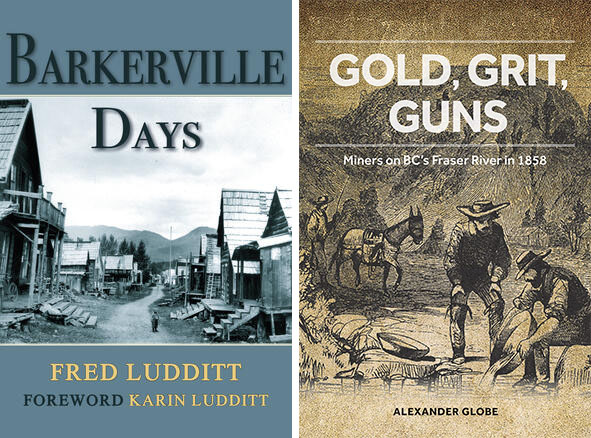
Gold, Grit, Guns: Miners on BC’s Fraser River in 1858 | Barkerville Days
Review By Christopher Herbert
September 27, 2023
BC Studies no. 219 Autumn 2023 | p. 136-137
The gold rushes of the Fraser River and the Cariboo were foundational events in the history of British Columbia. Two books, one new and one newly reprinted, aim to offer comprehensive histories of their respective rushes. Both also use rare or unique source material. In the case of Alexander Globe’s Gold, Grit, Guns, it is four rarely-examined journals, including one privately held by the author. In Barkerville Days, Fred Ludditt draws on decades of residence in Barkerville, interviews with old-timers, and his personal role in establishing what would become the world-renowned Barkerville Historic Town and Park.
Globe’s book is divided into three parts. The first, “The 1858 Setting,” is spread over four chapters and provides a narrative of the Fraser River Gold Rush that is awash in fine-grain details of specific mining areas, techniques, transportation routes, and the like. The second, “The Diarists in Fraser River Country, 1858,” gives each of the four diaries its own chapter. This is one of the strongest parts of the book, as each source is uncommonly rich and full of descriptive detail, far beyond the records of weather and expenses so prevalent in miner’s journals. The final part, “Looking Forward,” is essentially an epilogue. The value of the appendix must be noted. Globe has undertaken the herculean task of compiling a complete (or very nearly so) list of ships and shipping to Victoria and the Lower Mainland during 1858.
Overall, Gold, Grit, Guns is a fascinating, informative, but also uneven work. While Globe has conducted deep research into the primary sources of Fraser River rush, the work fails to engage with most of the major existing works on British Columbia and the gold rushes. This is disappointing because the insights gleaned from scholars such as Jean Barman, Tina Loo, and Adele Perry (for a start) would have measurably strengthened the analysis. The secondary literature that does appear tends to over-stress the threat posed by American miners and the intensity of conflicts with indigenous peoples. At the same time, Gold, Grit, Guns offers perhaps the single best account of the experiences of miners on the Lower Fraser. The level of detail is inspiring, especially as the book is also extremely readable. The picture that emerges of the hardships faced by the miners is compelling. This is especially true of the four chapters focused on the accounts left by George Slocumb, George Beam, Otis Parson, and an anonymous Canadian miner. Amongst all of this, Globe also tracks the environmental impact of the miners, showing how it not only affected contemporary events, but left lasting legacies for future generations.
The reprinting of Fred Ludditt’s Barkerville Days is a welcome event. Originally published in 1969 by a longtime resident of Barkerville (and gold miner himself) it has a roughly chronological organization. Most of the first ten chapters (each fairly short, the entire book comes in at 173 pages) focus on the height of the Cariboo rush in the early 1860s. Ludditt then spends the bulk of the next five chapters covering the period from the 1870s to 1930s, when Ludditt himself arrived in Barkerville. Some of the most interesting material is in the final two chapters, where Ludditt describes the efforts to preserve Barkerville’s history and the creation of the Barkerville Historic Town and Park.
Barkerville Days is the reflection of one man’s single-minded quest to preserve Barkerville’s history. Its organization is a bit scattered and tends toward a “Great Man” history of the rush emphasizing the heroic struggles of individual white men while virtually ignoring anyone else. Indeed, some of the latter sections of the book literally become a “Who’s Who” of Barkerville history. Ludditt also very clearly has an axe to grind with regard to the early governmental preservation efforts in Barkerville. For all that, though, modern readers can find much to inform and amuse in Barkerville Days. While subsequent scholars have done a lot to add nuance and detail to Ludditt’s account, the core descriptions of the rush stand the test of time. As a miner himself, Ludditt understands his historical subjects and their craft in a way most scholars aspire to, and this comes through in the pages of his book.
Both works add to our understanding of the gold rushes of British Columbia. Ludditt’s source is interesting both for the history it contains and as a piece of history itself. Despite being decades old, it remains an accessible and engaging account of the Cariboo gold rush and subsequent time periods. Indeed, one of the most disappointing things about the book is the relatively scant attention paid to the twentieth-century history of the region. The irony is that, thanks largely to Fred Ludditt and others like him, the history of the gold rush in the Cariboo is more accessible and well-known than more recent time periods! For its part, Globe’s work is filled with interesting nuggets and written in clear, lively prose. Globe’s identification of the value of the Beam, Slocumb, and Parsons sources should make them required reading for future scholars of the British Columbia gold rush. When paired with other recent scholarship on the gold rushes, both Gold, Grit, Guns and Barkerville Days are easy books to recommend. Both books should find a wide audience among the general public and scholars of British Columbia history.
Publication Information
Globe, Alexander. Gold, Grit, Guns: Miners on BC’s Fraser River in 1858. Vancouver: Ronsdale Press. 2022. 350 pp. $26.95 paper.
Ludditt, Fred. Barkerville Days. Qualicum Beach, BC: Caitlin Press. 2022. 192 pp. $26.00 paper.
